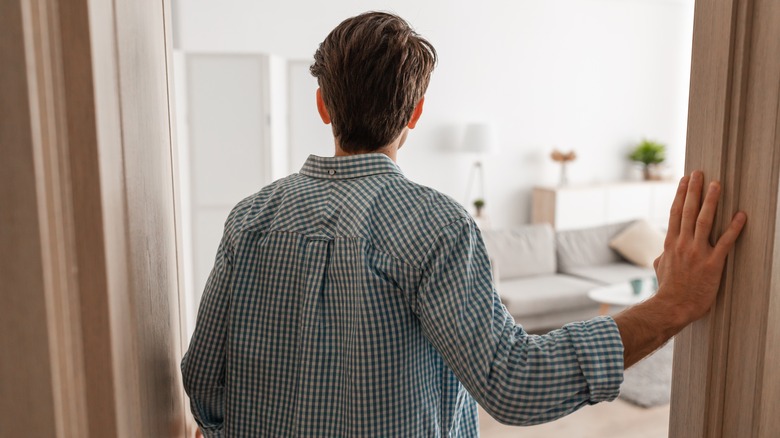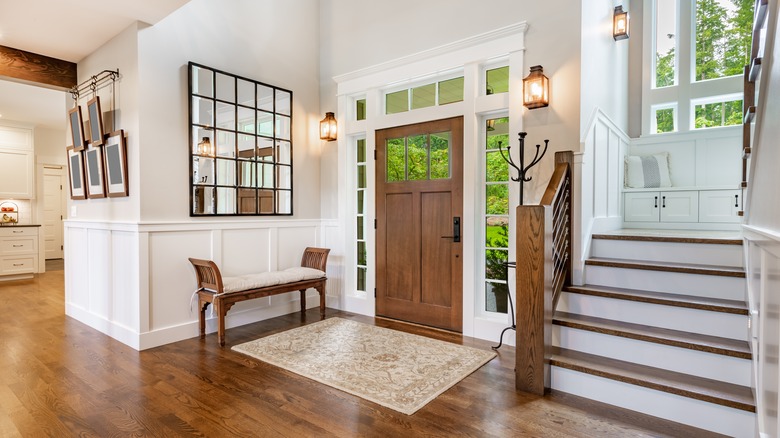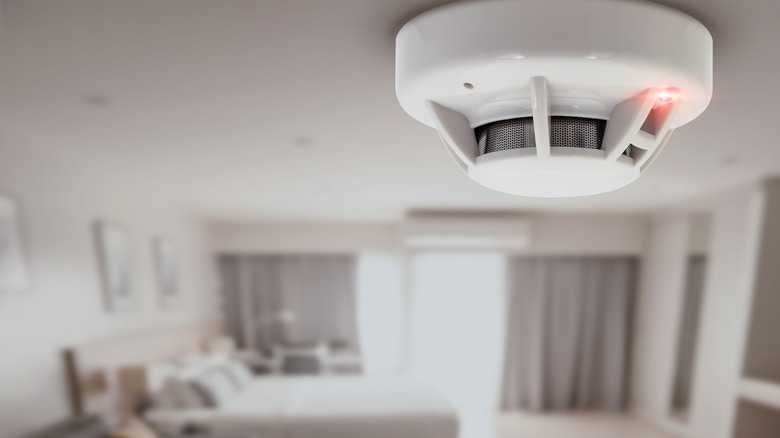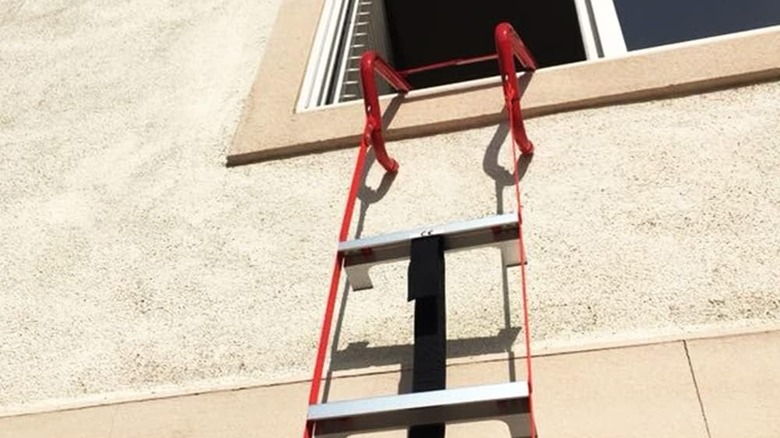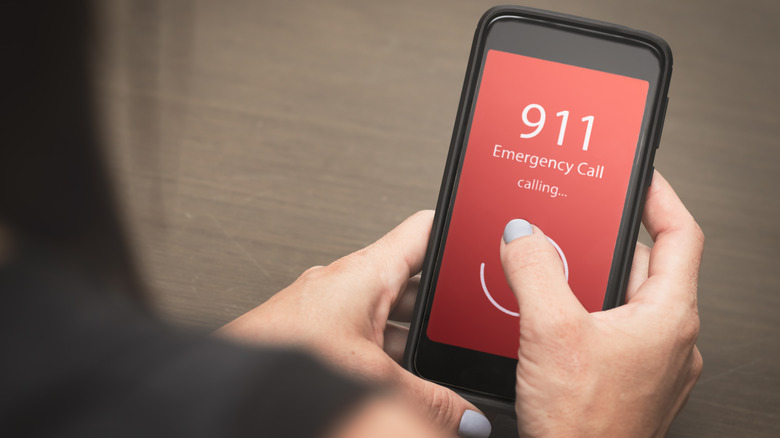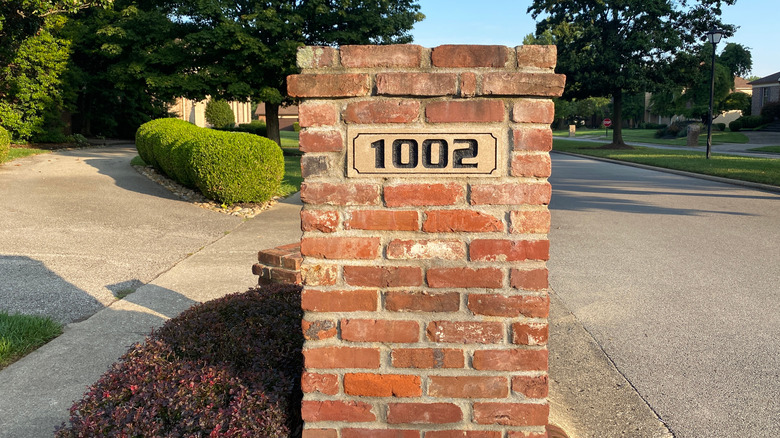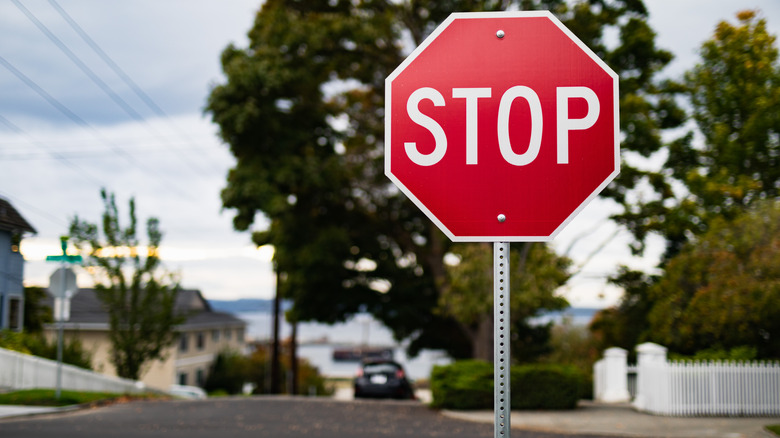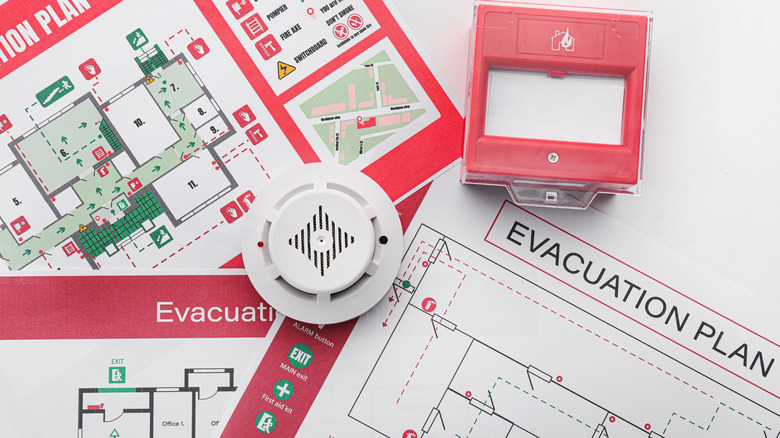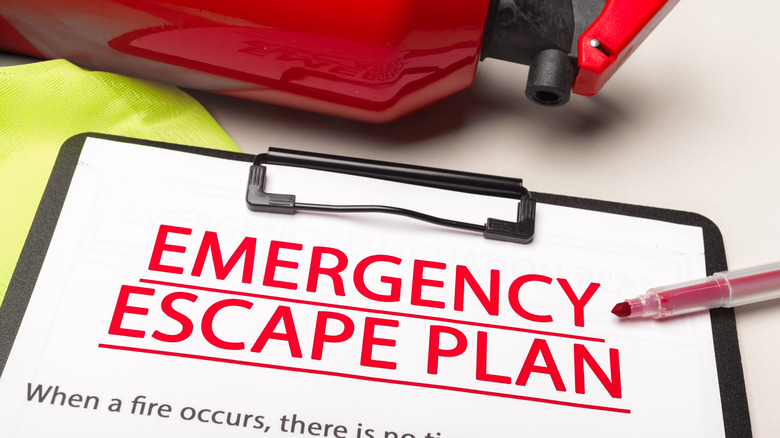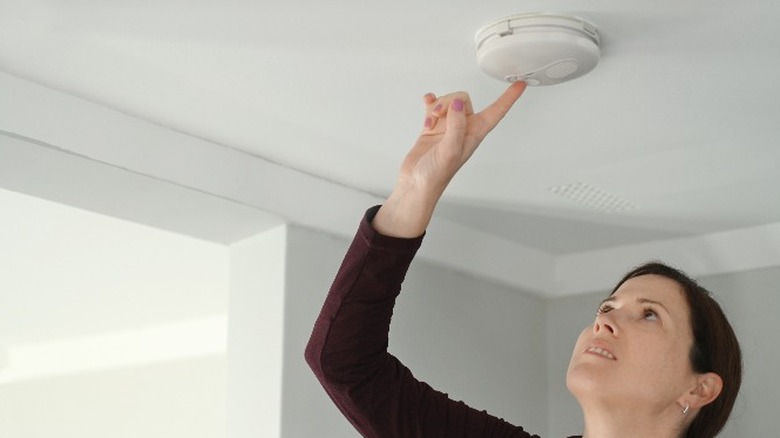Things To Consider When Coming Up With A House Fire Exit Plan
We may receive a commission on purchases made from links.
One never knows when tragedy will strike, which is why it is so important to be prepared for a worst-case scenario. According to the National Fire Protection Association, close to 4,000 Americans are killed in fires each year. Beyond this number, more than 14,000 additional individuals are injured due to these tragedies. Coming up with an exit plan can help you and others in the home to act quickly and get out in the event a fire does break out.
Unfortunately, if a fire does break out in your home, there won't be much time to act. It can take as little as 3.5 minutes for the temperature inside the house to rise above 1,100 degrees Fahrenheit. While having a plan is essential, it is also important to make sure that what you devise takes the appropriate considerations in mind to keep you and your loved ones safe. Here is what to think of when developing a fire escape plan.
Where are all the possible exits and escape routes in your home?
Before you start developing an escape plan, take several minutes to walk through the home. Even if you believe you can clearly picture the various spaces in your head, this walk-through aims to look at each room with a new purpose. You want to take note of any potential exit — whether it be a door, window, or balcony. Escaping during a fire is clearly going to be very different than strolling out of your home to head shopping or go to work, so there are likely potential exits you haven't registered.
Because identifying them is so important to ensuring the safety of each household member, take your time with this step. Ask another adult to walk through the house with you to provide a second set of eyes to make sure nothing is missed. Bring a clipboard with you, and write down all possible escape routes.
Are there two ways to exit each room?
After completing the home walk-through, you're ready to start devising the plan. As Ready.gov explains, having just one route out of each room is not sufficient. If the fire is blocking that exit, having a backup plan for how to get out could mean the difference between life and death. For example, if the only way you've planned to get out of your bedroom during a fire is through the door to the hall, what will you do if there are flames in the hallway or on the stairs leading to the main level?
This is where your earlier walk-through of the home will come in handy. Is there a window or balcony that would allow them access to the outside? Is there a way to get down from them if they're on the second floor? If not, you might need to research telescoping ladders. Is there a rear sliding door that offers an alternative route to avoid potential flames in the first exit path?
Are there any children or individuals with mobility issues that will require assistance?
Once the escape routes are mapped out, consider whether there are any individuals in the house who may not be able to get themselves out to safety. These individuals could include infants, young children, or adults with mobility limitations. Creating a plan to get these people safely out is an important step you don't want to overlook.
The best thing you can do is assign an adult household member to each child or adult with mobility limitations. In the event of a real fire, this adult would be responsible for staying with them and helping them to get out safely. Because you never know when a fire might strike, and who will or won't be home or available to help, your plan should also include a backup person. Once chosen, practice a fire drill a few times so they know to look for each other.
Will you be able to keep designated exits and escape routes clear?
A planned escape route will only work if it is clear and the exit is accessible. This means that you must take care to keep them unobstructed. While working on your plan, move anything that could impede a quick and safe escape. For example, if one of the escape windows is partially blocked with a dresser or bookcase, look for a new way to rearrange the furniture so that it is accessible. Similarly, if there are boxes or other stored items in the path of a basement or laundry door that is otherwise rarely used, find a new place to keep these items.
Once you have cleared the exit routes, it is important to get everyone in the home on board with keeping them clear. This could involve changing some habits about where items are left in the house. If you notice that one area is particularly difficult to keep clean, consider posting signs as a reminder to keep designated paths clear.
Does your home have smoke detectors where required?
Placing smoke detectors where recommended can help ensure that you and the others in the home are alerted to the presence of fire quickly, giving you more time to get out of the house safely. You need to make sure that you will hear an alarm sound when smoke is detected. House fires do not only occur during the day; they can also happen at night when everyone is sleeping. For this reason, the National Fire Protection Agency recommends installing a smoke detector inside every bedroom to make sure that people are woken up to act quickly.
In addition to that, there should also be a smoke detector outside of the sleeping areas (such as in the hallway) and on each floor of the home. For floors without sleeping areas, smoke detectors can be placed near the stairs and/or in family or living rooms. It is not recommended to put a smoke alarm in a kitchen due to the likelihood of a false alarm, so make sure they are placed a minimum of 10 feet from stoves, microwaves, and other cooking appliances. Because smoke rises, the best place for a detector is on the top of the wall, close to the ceiling.
Do any windows with security bars have an emergency release device?
Depending on where you live, you might not feel safe leaving your windows accessible to potential intruders from the outside. If you have young children, you may also fear for their safety if they were ever to open the window and jump or fall down. For these reasons, you may have window bars on some or all of the windows in your home. While security bars can protect against these perceived threats, they can introduce a new threat by preventing people from escaping in the event of a fire.
Fortunately, there are special devices that you can install to release these security bars in the event of an emergency. Called Window Bar Quick Release Kits, they feature a foot-operated component that will make the stationary bars pivot away from the window, clearing the path to escape. Be sure to check for compatibility with your unit and confirm that the device you select is approved for the city or state where you live. For example, these are not allowed in New York City.
If you have a two-story home, do you have escape ladders available for the rooms on the upper level?
Purchasing escape ladders for the upper rooms in a two- or three-story home is important. Look back at the two exit routes you identified for each room in your home. Chances are at least some of them involve getting out through a window. Having an escape ladder will make it possible to get down from upper stories much more safely and easily than if no ladder were available and you were forced to jump down instead.
When choosing escape ladders for your home, there are a few key things to keep in mind. One of the most important things is its length. Some ladders are only designed for use with two-story homes with a length between 13 and 16 feet. If you have a three-story house, you'll want to find a ladder that is closer to 30 feet. It is also important to look for models that will deploy quickly to avoid wasting precious time as you or others try to escape.
Does everyone in the home know how to call 911?
You undoubtedly know to call 911 in the event of a fire or other emergency. However, is that the case for everyone in your home, including children? Taking time to make sure that everyone can call 911 can help ensure that firefighters and other emergency personnel can get to your home as quickly as possible after the flames break out. Sit down with your young kids and show them how to dial the number. Make sure they understand that they must also press the "call" button when dialing from a cell phone. If your cell has a screen lock, show them where to press to make an emergency call without needing to unlock the screen.
In a fire, the most important thing to do is to get everyone out of the home quickly. So, explain to children (and others in your home) that they should wait to call 911 until they have safely evacuated. When showing them how to dial, they must also understand that it is the number to call for any type of genuine emergency, not just a fire. Stress the importance of only calling for real emergencies to avoid wasting resources that could be needed somewhere else.
Is your home's street number clearly visible to direct emergency personnel to your home?
When firefighters or other emergency personnel are responding to a call to your home, you don't want them to waste any time figuring out where to go. If the fire is still contained inside the home when they arrive, it may not be immediately clear which property needs help. Having your house number clearly visible from the street will direct them and other emergency workers to the right place.
When working on your exit plan, take a moment to step out of your home and walk down to the curb. Assess whether your house number is clear and easy to read from that distance. If it is not, now is the time to change that. You can purchase large house numbers to place above or next to your door, add your address to your mailbox, paint it on the curb, or do all of the above to make sure the firefighters don't waste precious time determining where they are needed.
Where should you meet after an evacuation?
During an evacuation, each family member should take the fastest route to get outside. This means that you and the others in the home may become separate from each other. To help everyone reunite quickly, setting up a safe meeting place is important. The location you choose should be far enough away from the home to make sure no one is threatened by potentially large flames. You can consider meeting in front of one of your neighbors' houses, at the corner of the street by a stop sign, or at another agreed-upon location.
Setting a meeting place will not only help you and the others in your home reunite after escaping, but it will also help minimize concern over whether someone is trapped inside. If someone is missing, you will want to share that information with firefighters as soon as they arrive — do not attempt to go back in yourself. However, you don't want to have the firefighters searching inside the home for a family member who had just ended up at a different neighbor's house or another safe location.
Should you hang your fire exit plan somewhere in your home?
After creating your fire exit plan, it is a good idea to write it down and make sure that everyone in the home understands it. Review the plan together and discuss the various aspects of it. If anyone in the house has any questions or concerns, now is the time to address them and make any necessary changes.
Posting the plan in each room of the home can also help people act quickly in the event of an emergency. You may also find it helpful to print out a floor plan for each room. Highlight the two potential exit routes to provide a quick visual for what to do in the event of an emergency. This can be especially helpful for young children, but it will also reassure adults that they will know how to get out if there is a fire. If you don't want a printout in multiple spots, consider posting it somewhere the family consistently sees, such as the kitchen command center.
How will you share your fire escape plan with visitors?
You want to ensure that everyone visiting your home remains safe in the event of a fire. For this reason, it is a good idea to share your plan with any guests, particularly those who will be staying overnight. Show them where the plan is posted and review the potential exit routes from the room where they will be sleeping. If there is a fire when they are staying over, this will help them safely navigate their way out of a less familiar space. For example, they might not be aware there is an escape ladder stored in the closet.
Similarly, if you (or your children) will be spending the night at a friend or family member's home, don't be afraid to ask your hosts about their escape plan. Making sure that you and those you love will remain safe when away from your home is important. If they have not created a fire escape plan, you can use it as an opportunity to help them understand the importance of developing one and can even share everything you've learned while building your own plan.
Have you set dates to practice your fire escape plan twice a year?
Spending time to develop a plan is important. However, if you don't practice following it, you won't be as prepared in the event of a real emergency. Because of how quickly conditions within a home can deteriorate during a fire, it is important to get out of the house in less than two minutes. The more you practice your plan and the more familiar you (and the others in the home) are with the different ways to exit, the faster you'll be at getting out.
Set a date for a home fire drill at least two times each year. Treat these drills as a real emergency and act as you would if the home were on fire. Move quickly to exit the home and head to the agreed-upon meeting place. Try the drill from different areas of the house to make sure that everyone is comfortable using the various highlighted exit routes. Now is the time to identify any potential obstacles that should be accounted for during a fire.
In a real fire, there will likely be smoke in the air, so practice crawling low to the ground to stay away from it. If you have young children, ensure they know what the alarm sounds like and what it tells them to do. Children may also likely be scared, so help them understand the importance of exiting the home quickly and that they should never hide from firefighters. Visit a fire station or consider showing them pictures of a firefighter in full gear to help ease this potential fear.

